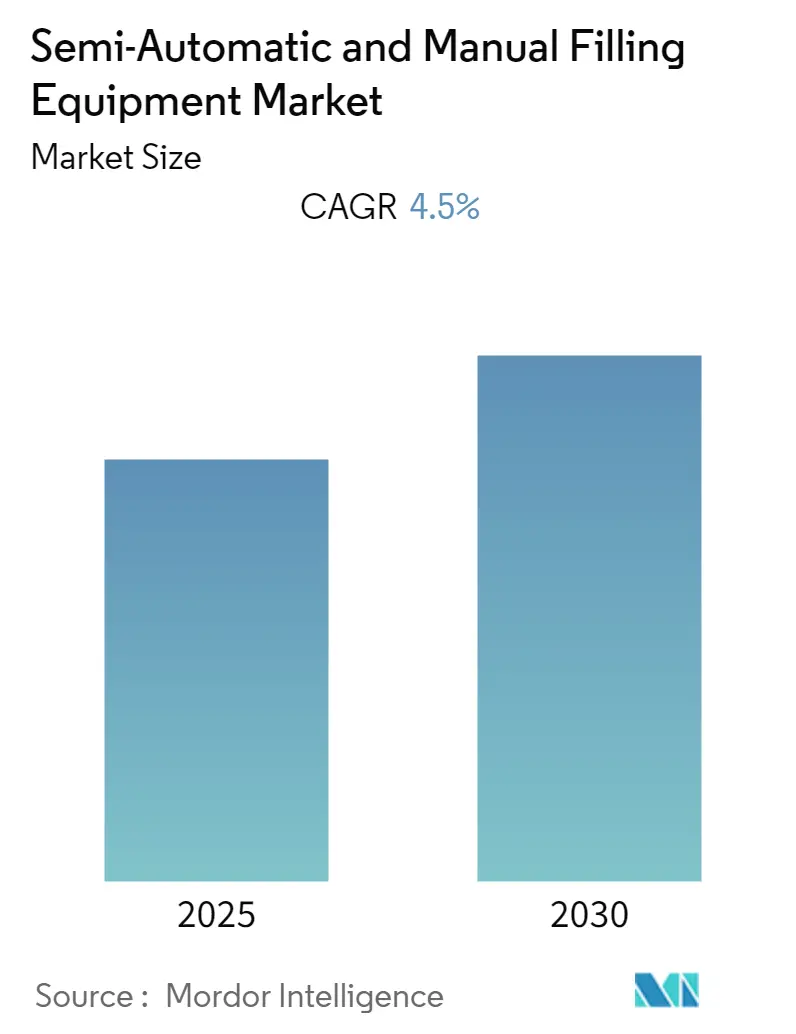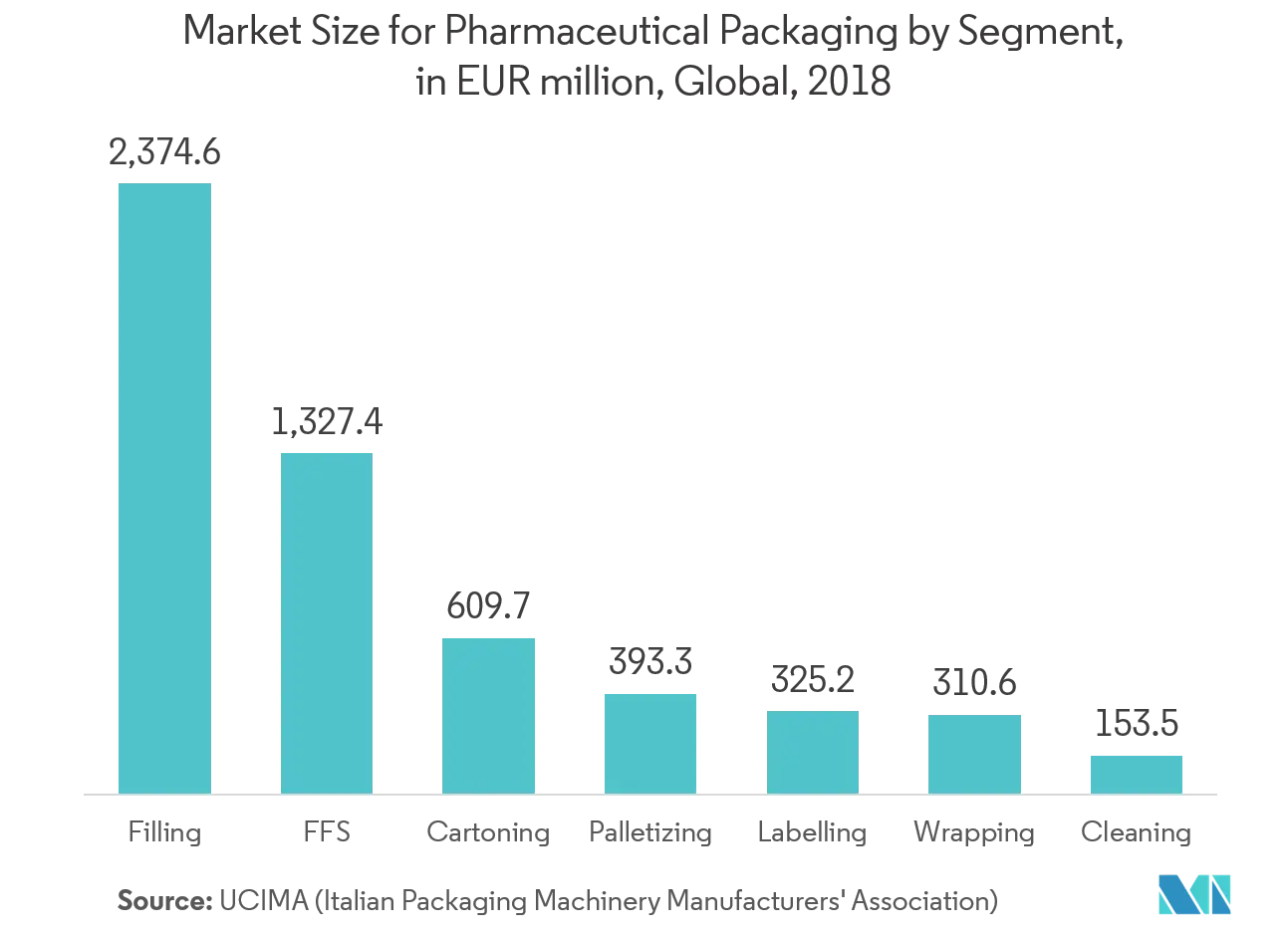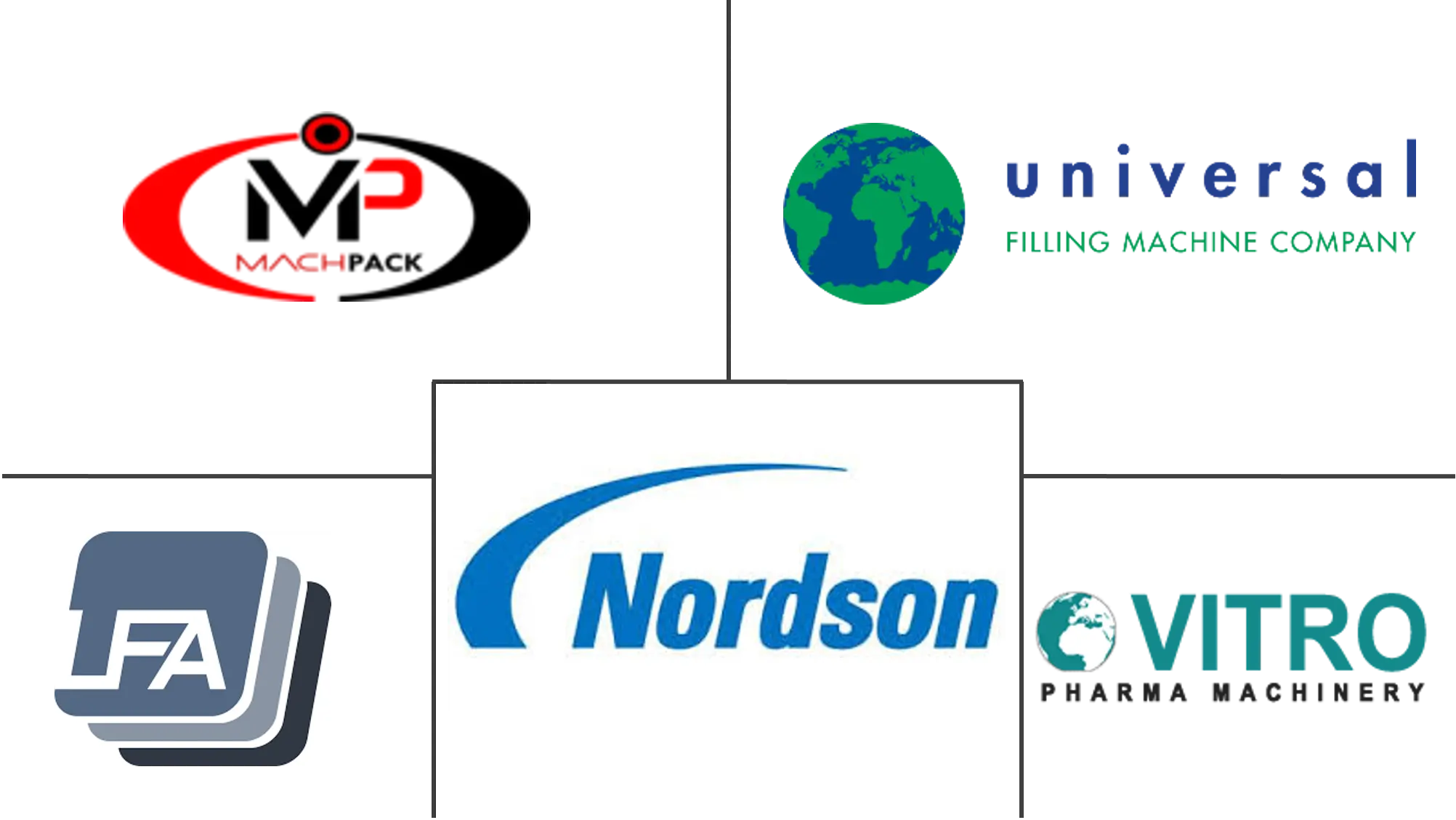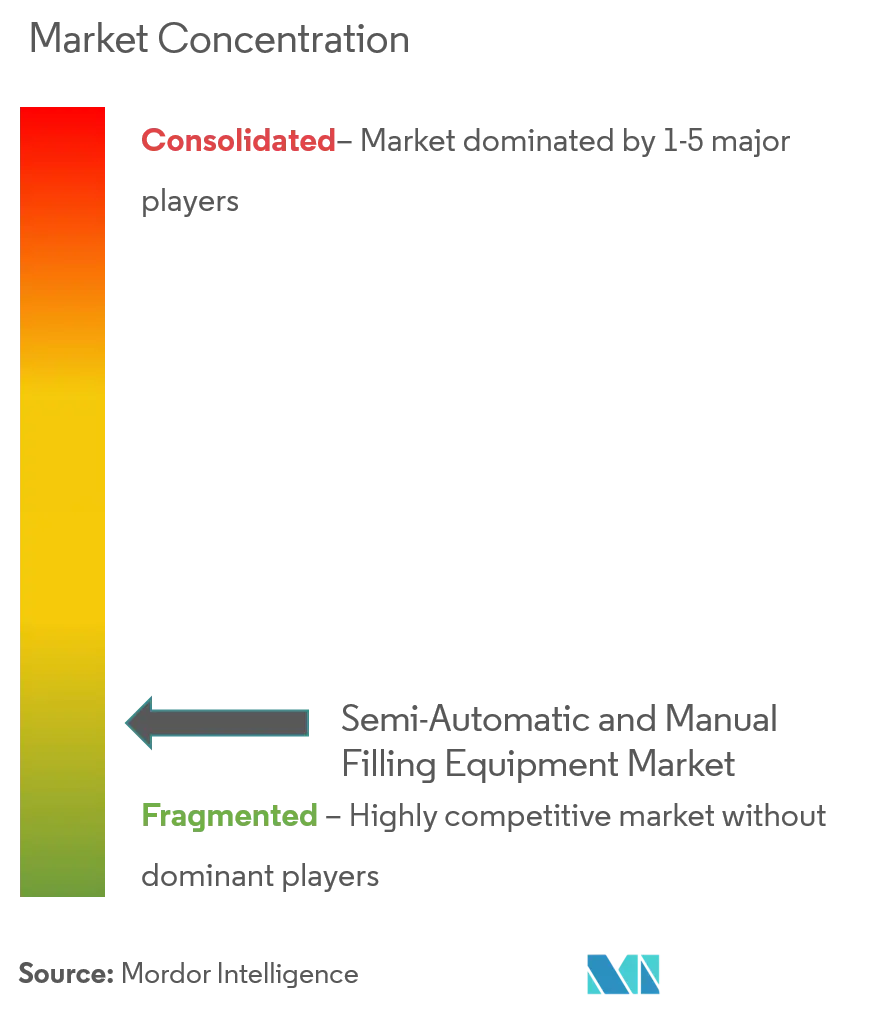
Semi-Automatic and Manual Filling Equipment Market Analysis
The Semi-Automatic and Manual Filling Equipment Market is expected to register a CAGR of 4.5% during the forecast period.
- The growing demand for filling equipment in the liquid food sector drives the market. According to the FAO( Food & Agriculture Organization of the United Nations), the dairy product demand in the developed and developing countries has been increasing for the past few years particularly in the North American region and the growing demand for fruit juice worldwide rose to 35 billion liters in 2017 which has also been crucial to the market growth.
- Also according to Canadean limited, in 2018 North America showed the highest consumption per capita per liter of fruit juice which is 22.7 and Western Europe with 18.9. This drives the growth of these liquid packaging by which the demand for mostly semi-automatic filling equipment increases in these regions.
- The growing demand to treat chronic diseases that requires continuous vaccination drives the market. Chronic diseases are the primary causes of death and disability globally. Disease rates from these conditions are accelerating globally, advancing across every region and pervading all socioeconomic classes. According to WHO, the estimated cases for chronic disease may reach around 60% globally. As the vaccines for such cases are available in pre-filled syringes form, its increased consumption is expected to boost the market growth.
- High maintenance costs for filling equipment restraints the growth of the market. These machines have a high failure rate and high corrective maintenance cost which deliberately slows down the production rate.
Semi-Automatic and Manual Filling Equipment Market Trends
Pharmaceutical Accounted for the Market Growth
- With the increasing demand for generic medicines and biologics, the demand for filling equipment is raising globally. According to IQVIA, the distribution of pharma sales is rising every year as in 2018, United States individually accounted for 47% of the global pharma sales, Europe accounted for 20% and emerging markets showed 21% of the sales. These stats drive the demand for filling equipment where vendors are incorporating the features into their equipment which are designed to reduce the risk of any contaminants entering the process.
- The companies are providing a wide range of packaging machinery like a liquid filling machine, powder filling machine, tube filling machine, etc. Syringe filling equipment provides large scale filling and ensures sterility and dispensing of correct volume where the usage of semi-automatic filling equipment is widely used, while vial filling equipment can fill hundreds of vials per minute while securing against product loss and inconsistent volume.
- The capsule filling machine is widely used and are in huge demand in pharmaceutical applications. These days, the majority of people are preferring to intake medications in the form of capsules. As a result, the demand for capsules is increasing in pharmaceutical industries where the companies prefer semi-automatic and manual filling equipment based on factors such as machine cost, size of batch operations and mostly manual capsule filler when it comes to handling difficult powders and products.
- For instance, Lodha International, one of the prominent players in manufacturing filling equipment for pharma provides filling in both types of equipment. In semi-automatic, the company mostly preferred to precision manufacturing requirements and has been developed as per the GMP standards and has the competency to produce an output rate of 25000 to 47000 capsules per hour. While manual filling equipment is preferred for small scale applications where it can fill and close capsules at a rate of 300 per cycles and is capable of producing 8000 capsules per hour.

Asia-Pacific to Witness Substantial Growth
- The Asia-Pacific regions attribute to the highest demand for skincare, and particularly luxury products, as stated by L'Oréal. Also, it is being favored by the rising disposable income of consumers, the trend of online shopping and with an increasing consumer base of people interested in personal hygiene and physical appearance. This is supported by highly populated countries, like India and China by which the usage of semi-automatic and manual filling equipment increases in this region for cosmetic creams, hair gel, lotion, scrubs, etc.
- Moreover, according to WHO, in the Southeast Asia region, cardiovascular diseases, chronic respiratory diseases, diabetes, and cancer are the foremost diseases by which the demand for medicines rises. According to the Department of Pharmaceuticals which comes under the Ministry of Chemicals and Fertilizers, in India pharmaceutical market turnover reached Rs 129,015 crore (USD 18.12 billion) in 2018, growing 9.4 percent year-on-year and exports revenue was USD 17.28 billion in FY18 and USD 19.14 billion in FY19. These stats drive the demand for filling equipment in this country.
- Also, some pharma packaging players are expanding their plants which attribute to the market growth. For instance, in March 2019, the pharmaceutical packaging company Schott Kaisha expanded its capacity to manufacture vials, pre-filled syringes, and sterile solutions. The company’s expansion plans include new sites in Gujarat and North India, along with the expansion and up-gradation of existing plants in Daman and Jambusar in Gujarat. With these developments, the demand for semi-automatic and manual filling equipment rises effectively in this country.
- Moreover, some players are a global supplier for these equipments and contribute to the growth of the market for this region. For instance, China's Guangdong Rich Packing Machinery Co. provides its manual filling equipment to about 30 provinces and cities in China country, and also to Southeast Asia, Japan, United States, Europe and other countries and regions.

Semi-Automatic and Manual Filling Equipment Industry Overview
The semi-automatic and manual filling equipment market is fragmented in nature as players are dispersed locally and globally with the filling processes in various end-users segment respectively. Moreover, new players are also placing their steps which increase more competition. Keyplayers areNordson Corporation,LFA Machines Oxford Ltd., etc. Recent developments in the market are -
- Jan 2018 -NJM, a ProMachproduct brand, introduces the Dara SX-310-RDL, an aseptic filling and closing machine for sterilized vials with RayDyLyocaps. Heretrays can be manually fed to the SX-310-RDL or the system can be integrated with an upstream washer and depyrogenation tunnel for continuous automated feeding.
Semi-Automatic and Manual Filling Equipment Market Leaders
-
Nordson Corporation
-
LFA Machines Oxford Ltd.
-
MachPack Process Machines
-
Universal Filling Machine Co.
-
Vitro Pharma Machinery
- *Disclaimer: Major Players sorted in no particular order
Semi-Automatic and Manual Filling Equipment Industry Segmentation
The Semi-Automatic and Manual Filling Equipment provide filling packaging process of solid, semi-solid and liquid products in various container types, vacuum bags, etc, for end users such as in foods, beverages, pharma, cosmetics, etc.
| By Material Type | Solid |
| Semi-Solid | |
| Liquid | |
| End-User | Food |
| Beverage | |
| Pharmaceutical | |
| Cosmetics & Household | |
| Other End-Users | |
| Geography | North America |
| Europe | |
| Asia-Pacific | |
| Latin America | |
| Middle-East & Africa |
Semi-Automatic and Manual Filling Equipment Market Research FAQs
What is the current Semi-Automatic and Manual Filling Equipment Market size?
The Semi-Automatic and Manual Filling Equipment Market is projected to register a CAGR of 4.5% during the forecast period (2025-2030)
Who are the key players in Semi-Automatic and Manual Filling Equipment Market?
Nordson Corporation, LFA Machines Oxford Ltd., MachPack Process Machines, Universal Filling Machine Co. and Vitro Pharma Machinery are the major companies operating in the Semi-Automatic and Manual Filling Equipment Market.
Which is the fastest growing region in Semi-Automatic and Manual Filling Equipment Market?
Asia Pacific is estimated to grow at the highest CAGR over the forecast period (2025-2030).
Which region has the biggest share in Semi-Automatic and Manual Filling Equipment Market?
In 2025, the North America accounts for the largest market share in Semi-Automatic and Manual Filling Equipment Market.
What years does this Semi-Automatic and Manual Filling Equipment Market cover?
The report covers the Semi-Automatic and Manual Filling Equipment Market historical market size for years: 2019, 2020, 2021, 2022, 2023 and 2024. The report also forecasts the Semi-Automatic and Manual Filling Equipment Market size for years: 2025, 2026, 2027, 2028, 2029 and 2030.
Our Best Selling Reports
Semi-Automatic and Manual Filling Equipment Industry Report
Statistics for the 2025 Semi-Automatic and Manual Filling Equipment market share, size and revenue growth rate, created by Mordor Intelligence™ Industry Reports. Semi-Automatic and Manual Filling Equipment analysis includes a market forecast outlook for 2025 to 2030 and historical overview. Get a sample of this industry analysis as a free report PDF download.




